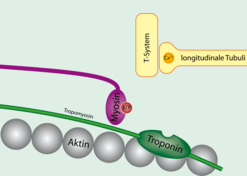Actin depolymerizing factor
Actin depolymerizing factors are a family of microfilament proteins associated with the rapid depolymerization of actin microfilaments that give actin its characteristic dynamic instability.[1] This dynamic instability is central to actin's role in muscle contraction, cell motility and transcription regulation.[2] The actin depolymerizing factor protein family includes cofilin/ADF, Cofilin-1, and Cofilin-2.[3]
Structure

The structure of actin depolymerizing factor is highly conserved across many organism due to actin's importance in many cellular processes.[4] Proteins of the actin depolymerizing factor family characteristically consist of five beta sheets, four antiparallel and one parallel, and four alpha helices with a central alpha helix providing the structure and stability of the proteins.[4] The actin depolymerizing factor homology domain (ADF-H domain) allows for binding to actin subunits and includes the central alpha helix, the N terminus extension, and the C terminus helix.[5][4]
- The N-terminus extension consists of a tilted loop that facilitates binding to G-actin but not F-actin due to steric hindrance present in F-actin.[4]
- The C-terminus can form hydrogen bonds to F actin through its amide backbone and a serine at position S274. This serine is especially highly evolutionarily conserved due to its importance in actin binding.[4]
- The central alpha helix is inserted into the hydrophobic cleft in between the first and third subunits of actin during actin binding.[4]
Mechanism of Action
F-actin (filamentous actin) is stabilized when it is bound to ATP due to the presence of a serine on the second subunit of actin that is able to form hydrogen bonds to the last phosphate group in ATP and a nearby histidine attached to the main loop. This interaction stabilizes the structure internally due to the interactions between the main loop and the second subunit. When ATP is hydrolyzed to ADP, the serine can no longer form a hydrogen bond to ADP due to the loss of the inorganic phosphate which causes the serine side chain to twist, causing a conformational change in the second subunit.[6][7] This conformational change also causes the serine to no longer be able to form a hydrogen bond with the histidine attached to the main loop and this weakens the linkage between subunits one and three, causing the entire molecule to twist. This twisting puts strain on the molecule and destabilizes it.[2]
Actin depolymerizing factor is able to bind to the destabilized F-actin by inserting the central helix into the cleft between the first and third subunits of actin. Actin depolymerizing factor binds F-actin cooperatively and induces a conformational change in F-actin that causes it to twist further and become more destabilized. This twisting causes severing of the bond between actin monomers, depolymerizing the filament.[2]
Regulation
Phosphorylation
Actin depolymerization factor is regulated by the phosphorylation of a serine on the C terminus by LIM kinases.[8] Actin depolymerizing factor is activated when it is dephosphorylated and inhibited when it is phosphorylated.[9]
pH

An alkaline environment stabilizes the inorganic phosphate released when ATP is hydrolyzed to ADP, so therefore a higher pH increases the favorability of the ATP bound to F-actin to be hydrolyzed to ADP resulting in the destabilization of actin.[10]
Tropomyosin binding
F-actin binds the protein Tropomyosin and actin depolymerizing factor competitively and mutually exclusively. F-actin binding of Tropomyosin is uncooperative so therefore the binding of Tropomyosin does not induce a conformational change in F-actin and does not cause it to become destabilized.[9] However, because F-actin cannot bind both Tropomyosin and actin depolymerizing factor at the same time due to Tropomyosin blocking the binding site of actin depolymerizing factor when it is bound to actin, Tropomyosin acts as a protector of actin against depolymerization.[11]
References
- Actin+Depolymerizing+Factors at the US National Library of Medicine Medical Subject Headings (MeSH)
- Dominguez R, Holmes KC (2011). "Actin structure and function". Annual Review of Biophysics. 40: 169–86. doi:10.1146/annurev-biophys-042910-155359. PMC 3130349. PMID 21314430.
- Menon S, Gupton SL (2016-01-01). "Building Blocks of Functioning Brain: Cytoskeletal Dynamics in Neuronal Development". International Review of Cell and Molecular Biology. 322: 183–245. doi:10.1016/bs.ircmb.2015.10.002. ISBN 9780128048092. PMC 4809367. PMID 26940519.
- Inada N (March 2017). "Plant actin depolymerizing factor: actin microfilament disassembly and more". Journal of Plant Research. 130 (2): 227–238. doi:10.1007/s10265-016-0899-8. PMC 5897475. PMID 28044231.
- Paavilainen VO, Oksanen E, Goldman A, Lappalainen P (July 2008). "Structure of the actin-depolymerizing factor homology domain in complex with actin". The Journal of Cell Biology. 182 (1): 51–9. doi:10.1083/jcb.200803100. PMC 2447895. PMID 18625842.
- "How do actin filaments depolymerize?". MBInfo. Retrieved 2018-06-16.
- Carlier MF, Laurent V, Santolini J, Melki R, Didry D, Xia GX, Hong Y, Chua NH, Pantaloni D (March 1997). "Actin depolymerizing factor (ADF/cofilin) enhances the rate of filament turnover: implication in actin-based motility". The Journal of Cell Biology. 136 (6): 1307–22. doi:10.1083/jcb.136.6.1307. PMC 2132522. PMID 9087445.
- Prunier C, Prudent R, Kapur R, Sadoul K, Lafanechère L (June 2017). "LIM kinases: cofilin and beyond". Oncotarget. 8 (25): 41749–41763. doi:10.18632/oncotarget.16978. PMC 5522193. PMID 28445157.
- Bamburg JR, McGough A, Ono S (September 1999). "Putting a new twist on actin: ADF/cofilins modulate actin dynamics". Trends in Cell Biology. 9 (9): 364–70. doi:10.1016/S0962-8924(99)01619-0. PMID 10461190.
- Pope BJ, Zierler-Gould KM, Kühne R, Weeds AG, Ball LJ (February 2004). "Solution structure of human cofilin: actin binding, pH sensitivity, and relationship to actin-depolymerizing factor". The Journal of Biological Chemistry. 279 (6): 4840–8. doi:10.1074/jbc.M310148200. PMID 14627701.
- Bernstein BW, Bamburg JR (1982). "Tropomyosin binding to F-actin protects the F-actin from disassembly by brain actin-depolymerizing factor (ADF)". Cell Motility. 2 (1): 1–8. doi:10.1002/cm.970020102. PMID 6890875.